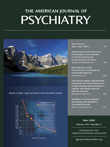Abstract
Objective: The suicide rate in schizophrenia is high, with the risk being highest early in the course. The rate of suicide attempts before treatment onset is also high and is often the event leading up to first treatment contact. A previous report showed that the duration of untreated psychosis can be reduced through an early detection program, and that the reduction was associated with lower symptom levels at treatment initiation. Treatment programs that bring first-episode patients into treatment at lower symptom levels can have the potential to reduce risk for suicide attempts. Method: The authors examined consecutive patients with nonorganic, nonaffective psychosis who sought initial treatment at psychiatric treatment units in four catchment areas: two that had an early detection program and two that did not. Results: The rate of severe suicidality (plans or attempts) was significantly higher in subjects from communities without the early detection program relative to those from early detection communities, even after adjustments for known predictors of suicidality. Conclusion: Early detection programs that bring patients into treatment at lower symptom levels may reduce suicidality risk at first treatment contact.



